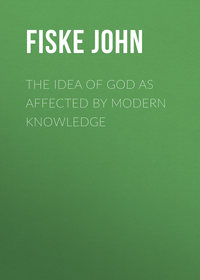 полная версия
полная версияA Century of Science, and Other Essays

John Fiske
A Century of Science, and Other Essays
DEDICATORY EPISTLE TO THOMAS SERGEANT PERRY, PROFESSOR OF ENGLISH LITERATURE IN THE KEIO GIJUKU, AT TOKYO
Dear Tom, – It has long been my wish to make you the patron saint or tutelar divinity of some book of mine, and it has lately occurred to me that it ought to be a book of the desultory and chatty sort that would remind you, in your present exile at the world's eastern rim, of the many quiet evenings of old, when, over a tankard of mellow October and pipe of fragrant Virginia, while Yule logs crackled blithely and the music of pattering sleet was upon the window-pane, we used to roam in fancy through the universe and give free utterance to such thoughts, sedate or frivolous, as seemed to us good. I dare say the present volume may serve as an epitome of many such old-time sessions of sweet discourse, which I trust we shall by and by repeat and renew.
But there is one link of association which in my mind especially connects you with the present occasion. My theory of the causes and effects of the prolongation of human infancy, with reference to the evolution of man, was first published in the "North American Review" for October, 1873, when you were the editor of that periodical. The article, which was entitled "The Progress from Brute to Man," was made up of two chapters of my "Outlines of Cosmic Philosophy" (part ii. chaps, xxi., xxii.), which was published a year later, in October, 1874. The value of the theory therein set forth was at once recognized by many leading naturalists. In the address of Vice-President Edward Morse, before the American Association, at its meeting at Buffalo in 1876, my theory receives extended notice as one of the most important contributions yet made to the Doctrine of Evolution; and it is declared that I have given "for the first time a rational explanation of the origin and persistence of family relations, and thence communal [i. e., clan] relations, and, finally, of society."1
Uncontrollable circumstances have prevented my giving to the further elaboration of this infancy theory the time and attention which it deserves and demands; but in my little book, "The Destiny of Man," published in 1884, I gave a popular exposition of it which has made it widely known in all English-speaking countries and on the continent of Europe, as well as among your worthy Japanese neighbours, Tom, who have done me the honour to translate some of my books into their vernacular. The theory has become still further popularized through having furnished the starting-point for some of the most characteristic speculations of the late Henry Drummond. In these and other ways my infancy theory has so far entered into the current thoughts of the present age that people have (naturally enough) begun to forget with whom it originated. For example, in the recent book, "Through Nature to God," while criticising a remark of Huxley's, I found it desirable to make a restatement of the infancy theory; whereupon a friendly reviewer, referring to that particular part of the book, observes that "of course" it makes no pretensions to originality, but is simply my lucid summary of speculations with which every reader of Darwin, Spencer, Huxley, Romanes, and Drummond is familiar! In point of fact, not the faintest suggestion of this infancy theory can be found in all the writings of Darwin, Huxley, and Romanes. In Spencer's "Sociology," vol. i. p. 630, it is briefly mentioned with approval as an important contribution originating with me; and in Drummond's "Ascent of Man," which is really built upon it, credit is cordially given me.2
Indeed, down to the present time, I have been left almost in exclusive possession of that area of speculation which is occupied with the genesis of Man as connected with that prolongation of infancy which first began to become conspicuous in the manlike apes. There are many who assent to what I have put forth, but few who seem inclined to enter that difficult field on the marchland between biology, psychology, and sociology. Doubtless this is because the attention of the scientific world has for forty years been absorbed in the more general questions concerning the competency of natural selection, the causes of variation, the agencies alleged by Lamarck, and in these latter days Weismannism, etc. In course of time, however, the more special problems connected with man's genesis will surely come uppermost, and then we may hope to see the causes of the lengthening of infancy investigated by thinkers duly conversant alike with psychology and embryology.
Questions of priority in originating new theories may not greatly interest the general reader, but you and I feel interested in preventing any misconception in the present case; and it was thus that the careless remark of the friendly reviewer led me to insert in the present volume the shorthand report of some autobiographical remarks on the infancy theory. In reading the proof-sheets I have noticed that the book contains elsewhere many allusions to personal experiences. This feature, which was quite unforeseen, will not fail to commend it all the more strongly to you, my ancient friend and comrade. As for readers in general, I may best conclude in the words of old Aaron Rathbone, whose book entitled "The Surveyor" was dated "from my lodging at the house of M. Roger Bvrgis, against Salisburie-house-gate, in the Strand, this sixt of Nouember, 1616." This wise and placid philosopher saith: "To perswade the courteous were causelesse, for they are naturally kind; and to diswade the captious were bootless, for they will not be diverted. Let the first make true vse of these my labours, and they shall find pleasure and profit therein; let the last (if they like not) leave it, and it shall not offend them."
Wherefore let me, without further ado, subscribe myself,
Ever yours,JOHN FISKE.Cambridge, October 25, 1899.I
A CENTURY OF SCIENCE 3
In the course of the year 1774 Dr. Priestley found that by heating red precipitate, or what we now call red oxide of mercury, a gas was obtained, which he called "dephlogisticated air," or, in other words, air deprived of phlogiston, and therefore incombustible. This incombustible air was oxygen, and such was man's first introduction to the mighty element that makes one fifth of the atmosphere in volume and eight ninths of the ocean by weight, besides forming one half of the earth's solid crust, and supporting all fire and all life. I know of nothing which can reveal to us with such startling vividness the extent of the gulf which the human mind has traversed within little more than a hundred years. It is scarcely possible to put ourselves back into the frame of mind in which oxygen was unknown, and no man could tell what takes place when a log of wood is burned on the hearth. The language employed by Dr. Priestley carries us back to the time when chemistry was beginning to emerge from alchemy. It was Newton's contemporary, Stahl, who invented the doctrine of phlogiston in order to account for combustion. Stahl supposed that all combustible substances contain a common element, or fire principle, which he called phlogiston, and which escapes in the process of combustion. Indeed, the act of combustion was supposed to consist in the escape of phlogiston. Whither this mysterious fire principle betook itself, after severing its connection with visible matter, was not too clearly indicated, but of course it was to that limbo far larger than purgatory, the oubliette wherein have perished men's unsuccessful guesses at truth. Stahl's theory, however, marked a great advance upon what had gone before, inasmuch as it stated the case in such a way as to admit of direct refutation. Little use was made of the balance in those days, but when it was observed that zinc and lead and sundry other substances grow heavier in burning, it seemed hardly correct to suppose that anything had escaped from these substances. To this objection the friends of the fire principle replied that phlogiston might weigh less than nothing, or, in other words, might be endowed with a positive attribute of levity, so that to subtract it from a body would increase the weight of the body. This was a truly shifty method of reasoning, in which your phlogiston, with its plus sign to-day and its minus sign to-morrow, exhibited a skill in facing both ways like that of an American candidate for public office.
Into the structure of false science that had been reared upon these misconceptions Dr. Priestley's discovery of oxygen came like a bombshell. As in so many other like cases, the discovery was destined to come at about that time; it was made again three years afterward by the Swedish chemist Scheele, without knowing what Priestley had done. The study of oxygen soon pointed to the conclusion that, whatever may escape during combustion, oxygen is always united with the burning substance. Then came Lavoisier with his balance, and proved that whenever a thing burns it combines with Priestley's oxygen, and the weight of the resulting product is equal to the weight of the substance burned plus the weight of oxygen abstracted from the air. Thus combustion is simply union with oxygen, and nothing escapes. No room was left for phlogiston. Men's thoughts were dephlogisticated from that time forth. The balance became the ruling instrument of chemistry. One further step led to the generalization that in all chemical changes there is no such thing as increase or diminution, but only substitution, and upon this fundamental truth of the indestructibility of matter all modern chemistry rests.
When we look at the stupendous edifice of science that has been reared upon this basis, when we consider the almost limitless sweep of inorganic and organic chemistry, the myriad applications to the arts, the depth to which we have been enabled to penetrate into the innermost proclivities of matter, it seems almost incredible that a single century can have witnessed so much achievement. We must admit the fact, but our minds cannot take it in; we are staggered by it. One thing stands out prominently, as we contrast this rapid and coherent progress with the barrenness of ancient alchemy and the chaotic fumbling of the Stahl period: we see the importance of untrammelled inquiry, and of sound methods of investigation which admit of verification at every step. That humble instrument the balance, working in the service of sovereign law, has been a beneficent Jinni unlocking the portals of many a chamber wherein may be heard the secret harmonies of the world.
It is not only in chemistry, however, that the marvellous advance of science has been exhibited. In all directions the quantity of achievement has been so marked that it is worth our while to take a brief general survey of the whole, to see if haply we may seize upon the fundamental characteristics of this great progress. In the first place, a glance at astronomy will show us how much our knowledge of the world has enlarged in space since the day when Priestley set free his dephlogisticated air.
The known solar system then consisted of sun, moon, earth, and the five planets visible to the naked eye. Since the days of the Chaldæan shepherds there had been no additions except the moons of Jupiter and Saturn. Herschel's telescope was to win its first triumph in the detection of Uranus in 1781. The Newtonian theory, promulgated in 1687, had come to be generally accepted, but there were difficulties remaining, connected with the planetary perturbations and the inequalities in the moon's motion, which the glorious labours of Lagrange and Laplace were presently to explain and remove, – labours which bore their full fruition two generations later, in 1845, when the discovery of the planet Neptune, by purely mathematical reasoning from the observed effects of its gravitation, furnished for the Newtonian theory the grandest confirmation known in the whole history of science. In Priestley's time, sidereal astronomy was little more than the cataloguing of such stars and nebulæ as could be seen with the telescopes then at command. Sixty years after the discovery of oxygen the distance of no star had been measured. In 1836, Auguste Comte assured his readers that such a feat was impossible, that the Newtonian theory could never be proved to extend through the interstellar spaces, and that the matter of which stars are composed may be entirely different in its properties from the matter with which we are familiar. Within three years the first part of this prophecy was disproved when Bessel measured the distance of the star 61 Cygni; since then the study of the movements of double and multiple stars has shown them conforming to Newton's law; and as for the matter of which they are composed, we are introduced to a chapter in science which even the boldest speculator of half a century ago would have derided as a baseless dream. The discovery of spectrum analysis and the invention of the spectroscope, completed in 1861 by Kirchhoff and Bunsen, have supplied data for the creation of a stellar chemistry; showing us, for example, hydrogen in Sirius and the nebula of Orion, sodium and potassium, calcium and iron, in the sun; demonstrating the gaseous character of nebulæ; and revealing chemical elements hitherto unknown, such as helium, a mineral first detected in the sun's atmosphere, and afterward found in Norway. A still more wonderful result of spectrum analysis is our ability to measure the motion of a star through a slight shifting in the wave-lengths of the light which it emits. In this way we can measure, in the absence of all parallax, the direct approach or recession of a star; and in somewhat similar wise has been discovered the cause of the long-observed variations of brilliancy in Algol. That star, which is about the size of our sun, has a dark companion not much smaller, and the twain are moving around a third body, also dark: the result is an irregular series of eclipses of Algol, and the gravitative forces exerted by the two invisible stars are estimated through their effects upon the spectrum of the bright star. In no department of science has a region of inference been reached more remote than this. From such a flight one may come back gently to more familiar regions while remarking upon the manifold results that have begun to be attained from the application of a sensitive photograph plate to the telescope in place of the human eye. It may suffice to observe that we thus catch the fleeting aspects of sun-spots and preserve them for study; we detect the feeble self-luminosity still left in such a slowly cooling planet as Jupiter; and since the metallic plate does not quickly weary, like the human retina, the cumulative effects of its long exposure reveal the existence of countless stars and nebulæ too remote to be otherwise reached by any visual process. By such photographic methods George Darwin has caught an equatorial ring in the act of detachment from its parent nebula, and the successive phases of the slow process may be watched and recorded by generations of mortals yet to come.
To appreciate the philosophic bearings of this vast enlargement of the mental horizon, let us recall just what happened when Newton first took the leap from earth into the celestial spaces by establishing a law of physics to which moon and apple alike conform. It was the first step, and a very long one, toward proving that the terrestrial and celestial worlds are dynamically akin, that the same kind of order prevails through both alike, that both are parts of one cosmic whole. So late as Kepler's time, it was possible to argue that the planets are propelled in their elliptic orbits by forces quite unlike any that are disclosed by purely terrestrial experience, and therefore perhaps inaccessible to any rational interpretation. Such imaginary lines of demarcation between earth and heavens were forever swept away by Newton, and the recent work of spectrum analysis simply completes the demonstration that the remotest bodies which the photographic telescope can disclose are truly part and parcel of the dynamic world in which we live.
All this enlargement of the mental horizon, from Newton to Kirchhoff, had reference to space. The nineteenth century has witnessed an equally notable enlargement with reference to time. The beginnings of scientific geology were much later than those of astronomy. The phenomena were less striking and far more complicated; it took longer, therefore, to bring men's minds to bear upon them. Antagonism on the part of theologians was also slower in dying out. The complaint against Newton, that he substituted Blind Gravitation for an Intelligent Deity, was nothing compared to the abuse that was afterwards lavished upon geologists for disturbing the accepted Biblical chronology. At the time when Priestley discovered oxygen, educated men were still to be found who could maintain with a sober face that fossils had been created already dead and petrified, just for the fun of the thing. The writings of Buffon were preparing men's minds for the belief that the earth's crust has witnessed many and important changes, but there could be no scientific geology until further progress was made in physics and chemistry. It was only in 1763 that Joseph Black discovered latent heat, and thus gave us a clue to what happens when water freezes and melts, or when it is turned into steam. It was in 1786 that the publication of James Hutton's "Theory of the Earth" ushered in the great battle between Neptunians and Plutonists which prepared the way for scientific geology. When the new science won its first great triumph with Lyell in 1830, the philosophic purport of the event was the same that was being proclaimed by the progress of astronomy. Newton proved that the forces which keep the planets in their orbits are not strange or supernatural forces, but just such as we see in operation upon this earth every moment of our lives. Geologists before Lyell had been led to the conclusion that the general aspect of the earth's surface with which we are familiar is by no means its primitive or its permanent aspect, but that there has been a succession of ages, in which the relations of land and water, of mountain and plain, have varied to a very considerable extent; in which soils and climates have undergone most complicated vicissitudes; and in which the earth's vegetable products and its animal populations have again and again assumed new forms, while the old forms have passed away. In order to account for such wholesale changes, geologists were at first disposed to imagine violent catastrophes brought about by strange agencies, – agencies which were perhaps not exactly supernatural, but were in some vague, unspecified way different from those which are now at work in the visible and familiar order of nature. But Lyell proved that the very same kind of physical processes which are now going on about us would suffice, during a long period of time, to produce the changes in the inorganic world which distinguish one geological period from another. Here, in Lyell's geological investigations, there was for the first time due attention paid to the immense importance of the prolonged and cumulative action of slight and unobtrusive causes. The continual dropping that wears away stones might have served as a text for the whole series of beautiful researches of which he first summed up the results in 1830. As astronomy was steadily advancing toward the proof that in the abysses of space the physical forces at work are the same as our terrestrial forces, so geology, in carrying us back to enormously remote periods of time, began to teach that the forces at work have all along been the same forces that are operative now. Of course, in that early stage when the earth's crust was in process of formation, when the temperature was excessively high, there were phenomena here such as can no longer be witnessed, but for which we must look to big planets like Jupiter; in that intensely hot atmosphere violent disturbances occur, and chemical elements are dissociated which we are accustomed to find in close combination here. But ever since our earth cooled to a point at which its solid crust acquired stability, since the earliest mollusks and vertebrates began to swim in the seas and worms to crawl in the damp ground, if at almost any time we could have come here on a visit, we should doubtless have found things going on at measured pace very much as at present, – here and there earthquake and avalanche, fire and flood, but generally rain falling, sunshine quickening, herbage sprouting, creatures of some sort browsing, all as quiet and peaceful as a daisied field in June, without the slightest visible presage of the continuous series of minute secular changes that were gradually to transform a Carboniferous world into what was by and by to be a Jurassic world, and that again into what was after a while to be an Eocene world, and so on, until the aspect of the world that we know to-day should noiselessly steal upon us.
When once the truth of Lyell's conclusions began to be distinctly realized, their influence upon men's habits of thought and upon the drift of philosophic speculation was profound. The conception of Evolution was irresistibly forced upon men's attention. It was proved beyond question that the world was not created in the form in which we find it to-day, but has gone through many phases, of which the later are very different from the earlier; and it was shown that, so far as the inorganic world is concerned, the changes can be much more satisfactorily explained by a reference to the ceaseless, all-pervading activity of gentle, unobtrusive causes such as we know than by an appeal to imaginary catastrophes such as we have no means of verifying. It began to appear, also, that the facts which form the subject-matter of different departments of science are not detached and independent groups of facts, but that all are intimately related one with another, and that all may be brought under contribution in illustrating the history of cosmic events. It was a sense of this interdependence of different departments that led Auguste Comte to write his "Philosophie Positive," the first volume of which appeared in 1830, in which he sought to point out the methods which each science has at command for discovering truth, and the manner in which each might be made to contribute toward a sound body of philosophic doctrine. The attempt had a charm and a stimulus for many minds, but failed by being enlisted in the service of sundry sociological vagaries upon which the author's mind was completely wrecked. "Positivism," from being the name of a potent scientific method, became the name of one more among the myriad ways of having a church and regulating the details of life.
While the ponderous mechanical intellect of Comte was striving to elicit the truth from themes beyond its grasp, one of the world's supreme poets had already discerned some of the deeper aspects of science presently to be set forth. By temperament and by training, Goethe was one of the first among evolutionists. The belief in an evolution of higher from lower organisms could not fail to be strongly suggested to a mind like his as soon as the classification of plants and animals had begun to be conducted upon scientific principles. It is not for nothing that a table of classes, orders, families, genera, and species, when graphically laid out, resembles a family tree. It was not long after Linnæus that believers in some sort of a development theory, often fantastic enough, began to be met with. The facts of morphology gave further suggestions in the same direction. Such facts were first generalized on a grand scale by Goethe in his beautiful little essay on "The Metamorphoses of Plants," written in 1790, and his "Introduction to Morphology," written in 1795, but not published until 1807. In these profound treatises, which were too far in advance of their age to exert much influence at first, Goethe laid the philosophic foundations of comparative anatomy in both vegetal and animal worlds. The conceptions of metamorphosis and of homology, which were thus brought forward, tended powerfully toward a recognition of the process of evolution. It was shown that what under some circumstances grows into a stem with a whorl of leaves, under other circumstances grows into a flower; it was shown that in the general scheme of the vertebrate skeleton a pectoral fin, a fore leg, and a wing occupy the same positions: thus was strongly suggested the idea that what under some circumstances developed into a fin might under other circumstances develop into a leg or a wing. The revelations of palæontology, showing various extinct adult forms, with corresponding organs in various degrees of development, went far to strengthen this suggestion, until an unanswerable argument was reached with the study of rudimentary organs, which have no meaning except as remnants of a vanished past during which the organism has been changing. The study of comparative embryology pointed in the same direction; for it was soon observed that the embryos and larvæ of the higher forms of each group of animals pass, "in the course of their development, through a series of stages in which they more or less completely resemble the lower forms of the group."4









